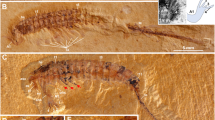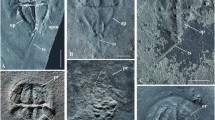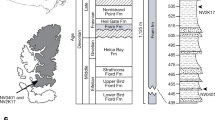Abstract
Xiphosurida—crown group horseshoe crabs—are a group of morphologically conservative marine chelicerates (at least since the Jurassic). They represent an idealised example of evolutionary stasis. Unfortunately, body fossils of horseshoe crabs seldom preserve appendages and their associated features; thus, an important aspect of their morphology is absent in explorations of their conservative Bauplan. As such, fossil horseshoe crab appendages are rarely considered within a comparative framework: previous comparisons have focussed almost exclusively on extant taxa to the exclusion of extinct taxa. Here, we examine eight specimens of the xiphosurid Tachypleus syriacus (Woodward, 1879) from the Cenomanian (ca 100 Ma) Konservat-Lagerstätten of Lebanon, five of which preserve the cephalothoracic and thoracetronic appendages in exceptional detail. Comparing these appendages of T. syriacus with other fossil xiphosurids highlights the conserved nature of appendage construction across Xiphosurida, including examples of Austrolimulidae, Paleolimulidae, and Limulidae. Conversely, Belinuridae have more elongate cephalothoracic appendages relative to body length. Differences in appendage sizes are likely related to the freshwater and possible subaerial life modes of belinurids, contrasting with the primarily marine habits of other families. The morphological similarity of T. syriacus to extant members of the genus indicates that the conserved nature of the generic lineage can be extended to ecological adaptations, notably burrowing, swimming, possible diet, and sexual dimorphism.











Similar content being viewed by others
References
Akbar John B, Kamaruzzaman BY, Jalal KCA, Zaleha K (2012) Feeding ecology and food preferences of Carcinoscorpius rotundicauda collected from the Pahang nesting grounds. Sains Malaysiana 41(7):855–861
Anderson LI (1996) Taphonomy and taxonomy of Palaeozoic Xiphosura. University of Manchester, Ph.D. thesis
Audo D, Charbonnier S (2012a) Late Cretaceous crest-bearing shrimps from the Sahel Alma Lagerstätte of Lebanon. Acta Palaeontol Pol 58(2):335–349
Audo D, Charbonnier S (2012b) New nisto of slipper lobster (Decapoda: Scyllaridae) from the Hadjoula Lagerstätte (Late Cretaceous, Lebanon). J Crustac Biol 32(4):583–590
Avise JC, Nelson WS, Sugita H (1994) A speciational history of "living fossils": molecular evolutionary patterns in horseshoe crabs. Evolution 48(6):1986–2001
Babcock LE, Merriam DF (2000) Horseshoe crabs (Arthropoda: Xiphosurida) from the Pennsylvanian of Kansas and elsewhere. Trans Kans Acad Sci 103(1):76–94
Babcock LE, Merriam DF, West RR (2000) Paleolimulus, an early limuline (Xiphosurida), from Pennsylvanian-Permian Lagerstätten of Kansas and taphonomic comparison with modern Limulus. Lethaia 33(3):129–141
Barthel KW, Swinburne NHM, Conway Morris S (1990) Solnhofen, a study in Mesozoic palaeontology. Cambridge University Press, Cambridge
Beecher CE (1904) Note on a new Permian xiphosuran from Kansas. Am J Sci 18(103):23–24
Bernier P, Barale G, Bourseau JP, Buffetaut E, Gaillard C, Gall JC, Wenz S (2014) The lithographic limestones of Cerin (southern Jura Mountains, France). A synthetic approach and environmental interpretation. Comptes Rendus Palevol 13(5):383–402
Bicknell RDC, Klinkhamer AJ, Flavel RJ, Wroe S, Paterson JR (2018a) A 3D anatomical atlas of appendage musculature in the chelicerate arthropod Limulus polyphemus. PLoS One 13(2):e0191400
Bicknell RDC, Ledogar JA, Wroe S, Gutzler BC, Watson WH III, Paterson JR (2018b) Computational biomechanical analyses demonstrate similar shell-crushing abilities in modern and ancient arthropods. Proc R Soc B Biol Sci 285(1889):20181935
Bicknell RDC, Paterson JR, Caron JB, Skovsted CB (2018c) The gnathobasic spine microstructure of recent and Silurian chelicerates and the Cambrian artiopodan Sidneyia: functional and evolutionary implications. Arthropod Struct Dev 47(1):12–24
Bicknell RDC, Pates S (2019) Abnormal extant xiphosurids in the Yale Peabody Museum Invertebrate Zoology Collection. B Peabody Mus Nat Hi 60(1):41–53
Bicknell RDC, Pates S, Botton ML (2018d) Abnormal xiphosurids, with possible application to Cambrian trilobites. Palaeontol Electron 21(2):1–17
Bicknell RDC, Žalohar J, Miklavc P, Celarc B, Križnar M, Hitij T (2019). A new limulid genus from the Strelovec Formation (Middle Triassic, Anisian) of northern Slovenia. Geological Magazine, in press: 1–14, doi: 10.1017/S0016756819000323
Błażejowski B (2015) The oldest species of the genus Limulus from the late Jurassic of Poland. In: Carmichael RH, Botton ML, Shin PKS, Cheung SG (eds) Changing Global Perspectives on Horseshoe Crab Biology, Conservation and Management. Springer, Basel, pp 3–14
Błażejowski B, Gieszcz P, Tyborowski D (2016) New finds of well-preserved Tithonian (late Jurassic) fossils from the Owadów-Brzezinki Quarry, Central Poland: a review and perspectives. Volumina Jurassica 14:123–132
Botton ML (1984) Diet and food preferences of the adult horseshoe crab Limulus polyphemus in Delaware Bay, New Jersey, USA. Mar Biol 81(2):199–207
Bracchi G, Alessandrello A (2005) Paleodiversity of the free-living polychaetes (Annelida, Polychaeta) and description of new taxa from the Upper Cretaceous Lagerstätten of Haqel. Hadjula and Al-Namoura (Lebanon) 32(3):1–64
Briggs DEG (2003) The role of decay and mineralization in the preservation of soft-bodied fossils. Annu Rev Earth Planet Sci 31(1):275–301
Briggs DEG, Moore RA, Shultz JW, Schweigert G (2005) Mineralization of soft-part anatomy and invading microbes in the horseshoe crab Mesolimulus from the Upper Jurassic Lagerstätte of Nusplingen, Germany. Proc R Soc Lond B Biol Sci 272(1563):627–632
Briggs DEG, Wilby PR (1996) The role of the calcium carbonate-calcium phosphate switch in the mineralization of soft-bodied fossils. J Geol Soc 153(5):665–668
Charbonnier S, Audo D, Garassino A, Hyžný M (2017a) Fossil Crustacea of Lebanon. Publications Scientifiques du Muséum, Paris
Charbonnier S, Teruzzi G, Audo D, Lasseron M, Haug C, Haug JT (2017b) New thylacocephalans from the Cretaceous Lagerstätten of Lebanon. Bulletin de la Société géologique de France 188(3):19
Dalla Vecchia FM, Arduini P, Kellner AWA (2001) The first pterosaur from the Cenomanian (Late Cretaceous) Lagerstätten of Lebanon. Cretac Res 22(2):219–225
Darwin C (1859) The origin of species by means of natural selection. John Murray, London
Darwin C (1871) The descent of man. John Murray, London
de Fabrègues PC, Claire P, Allain R (2013) A limulid trackway from the Late Jurassic (Tithonian) Lagerstätte of Canjuers (Var, France). Comptes Rendus Palevol 12(4):181–189
Desmarest A-G (1817) Crustacés fossiles, in Société de Naturalistes et d’Agriculteurs (eds), Nouveau Dictionnaire d’Histoire naturelle, appliquée aux Arts, à l’Agriculture, à l’Économie rurale et domestique, à la Médecine, etc. . Deterville, Paris
Desmarest A-G (1822) Les crustacés proprement dits. In: Brongniart A, Desmarest A-G (eds) Histoire naturelle des crustacés fossiles, sous les rapports zoologiques et geologiques. F.-G. Levrault, Paris, pp 67–142
Dunbar CO (1923) Kansas Permian insects, part 2, Paleolimulus, a new genus of Paleozoic Xiphosura, with notes on other genera. Am J Sci 5(30):443–454
Dunlop JA, Lamsdell JC (2017) Segmentation and tagmosis in Chelicerata. Arthropod Struct Dev 46(3):396–418
Fairuz-Fozi N, Satyanarayana B, Mat Zauki NA, Muslim AM, Husain ML, Ibrahim S, Nelson BR (2018) Carcinoscorpius rotundicauda (Latreille, 1802) population status and spawning behaviour at Pendas coast, Peninsular Malaysia. Glob Ecol Conserv 15:e00422
Farley RD (2010) Book gill development in embryos and first and second instars of the horseshoe crab Limulus polyphemus L.(Chelicerata, Xiphosura). Arthropod Structure & Development 39(5):369–381
Fisher DC (1977) Functional significance of spines in the Pennsylvanian horseshoe crab Euproops danae. Paleobiology 3(2):175–195
Fisher DC (1979) Evidence for subaerial activity of Euproops danae (Merostomata, Xiphosurida). In: Nitecki MH (ed) Mazon Creek Fossils. Elsevier, New York, pp 379–447
Fisher DC (1981) The role of functional analysis in phylogenetic inference: examples from the history of the Xiphosura. Am Zool 21(1):47–62
Fisher DC (1982) Phylogenetic and macroevolutionary patterns within the Xiphosurida. Proceedings of the Third North American Paleontological Convention 1:175–180
Gaillard C (2011) A giant limulid trackway (Kouphichnium lithographicum) from the lithographic limestones of Cerin (Late Kimmeridgian, France): ethological and environmental implications. Swiss J Geosci 104(1):57–72
Garassino A, De Angeli A, Pasini G (2009) A new hermit crab (Crustacea, Anomura, Paguroidea) from the Late Cretaceous (Cenomanian) of Lebanon. Atti della Società italiana di scienze naturali e del museo civico di storia naturale di. Milano 150(2):215–228
Gayet M, Belouze A, Saad PA (2003) Les poissons fossiles. Éditions DésIris, Méolans-Revel
Haug C, Rötzer MAIN (2018) The ontogeny of the 300 million year old xiphosuran Euproops danae (Euchelicerata) and implications for resolving the Euproops species complex. Dev Genes Evol 228(1):63–74
Haug C, Van Roy P, Leipner A, Funch P, Rudkin DM, Schöllmann L, Haug JT (2012) A holomorph approach to xiphosuran evolution—a case study on the ontogeny of Euproops. Dev Genes Evol 222(5):253–268
Hauschke N, Wilde V (2004) Palaeogene limulids (Xiphosura) from Saxony-Anhalt (Germany): systematics and palaeobiogeography. Hallesches Jahrbüch für Geowissenschaften, Reihe B 18:161–168
Holland FD, Erickson JM, O’Brien DE (1975) Casterolimulus: a new late Cretaceous generic link in limulid lineage. Bull Am Paleontology 62:235–249
Hu S-x, Zhang Q-y, Feldmann RM, Benton MJ, Schweitzer CE, Huang J, Wen W, Zhou C, Xie T, Lü T, Hong S (2011) The Luoping biota: exceptional preservation, and new evidence on the Triassic recovery from end-Permian mass extinction. Proc R Soc B Biol Sci 278(1716):2274–2282
Hu S, Zhang Q, Feldmann RM, Benton MJ, Schweitzer CE, Huang J, Wen W, Zhou C, Xie T, Lü T, Hong S (2017) Exceptional appendage and soft-tissue preservation in a Middle Triassic horseshoe crab from SW China. Sci Rep 7(1):14112
Kaplan R, Li SSL, Kehoe JM (1977) Molecular characterization of limulin, a sialic acid binding lectin from the hemolymph of the horseshoe crab, Limulus polyphemus. Biochemistry 16(19):4297–4303
Kin A, Błażejowski B (2014) The horseshoe crab of the genus Limulus: living fossil or stabilomorph? PLoS One 9(10):e108036
Knell RJ, Naish D, Tomkins JL, Hone DW (2013) Is sexual selection defined by dimorphism alone? A reply to Padian and Horner. Proc Zool Soc London 35:491–562
Lamsdell JC (2016) Horseshoe crab phylogeny and independent colonizations of fresh water: ecological invasion as a driver for morphological innovation. Palaeontology 59(2):181–194
Lamsdell JC, McKenzie SC (2015) Tachypleus syriacus (Woodward)—a sexually dimorphic Cretaceous crown limulid reveals underestimated horseshoe crab divergence times. Ord Divers Evol 15(4):681–693
Lange W (1923). Über neue Fossilfunde aus der Trias von Göttingen. Zeitschrift der deutschen geologischen Gesellschaft 74: 162–168
Lankester ER (1881) Limulus an Arachnid. Q J Microsc Sci 23:504–649
Latreille PA (1802) Histoire naturelle, générale et particulière, des crustacés et des insectes. Dufart, Paris
Leach WE (1819) Entomostraca. Dictionaire des Science Naturelles. Levrault and Schoell, Paris
Linnaeus C (1758) Systema naturæ per regna tria naturæ, secundum classes, ordines, genera, species, cum characteribus, differentiis, synonymis, locis. Laurentius Salvius, Holmia.
Mallon JC (2017) Recognizing sexual dimorphism in the fossil record: lessons from nonavian dinosaurs. Paleobiology 43(3):495–507
Meek FB, Worthen AH (1865). Notice of some new types of organic remains, from the Coal Measures of Illinois. Proceedings of the Academy of Natural Sciences of Philadelphia 17(1): 41–48.
Meischner K-D (1962) Neue Funde von Psammolimulus gottingensis (Merostomata, Xiphosura) aus dem Mittleren Buntsandstein von Göttingen. Paläontol Z 36(1):185–193
Moreau J-D, Fara E, Gand G, Lafaurie G, Baret L (2014) Gigantism among Late Jurassic limulids: new ichnological evidence from the Causses Basin (Lozère, France) and comments on body-size evolution among horseshoe crabs. Geobios 47(4):237–253
Müller OF (1785) Entomostraca seu Insecta Testacea, quae in aquis Daniae et Norvegiae reperit, descripsit et iconibus illustravit. Symtibus Bibliopolii J.G. Mülleriani, Müller, O. F. Lipsiae et Havniae, Leipzig and Copenhagen
Münster GG (1839) Die Rhyncholiten des Muschelkalks mit ihrem Fortsätzen. In: Münster GG (ed) Beiträge zur Petrefacten-Kunde. In Commission der Buchner'schen Buchhandlung, Bayreuth, pp 48–51
Obst M, Faurby S, Bussarawit S, Funch P (2012) Molecular phylogeny of extant horseshoe crabs (Xiphosura, Limulidae) indicates Paleogene diversification of Asian species. Mol Phylogenet Evol 62(1):21–26
Oukassou M, Lagnaoui A, Charrière A, Saber H, Haouz WB, Gierliński GD, Klein H, Ibouh H (2018) New evidence of xiphosurids from the Middle Jurassic of Morocco: Palaeoenvironmental, palaeoecological and palaeobiogeographical implications. Palaeogeogr Palaeoclimatol Palaeoecol 516:268–283
Owen R (1872) On the anatomy of the American king-crab (Limulus polyphemus, Latr.). Trans Linn Soc London 28(3):459–506
Packard AS (1885) On the Carboniferous xiphosurous fauna of North America. Mem Natl Acad Sci 3:143–157
Padian K, Horner JR (2011) The definition of sexual selection and its implications for dinosaurian biology. J Zool 283(1):23–27
Padian K, Horner JR (2014) The species recognition hypothesis explains exaggerated structures in non-avialan dinosaurs better than sexual selection does. Comptes Rendus Palevol 13(2):97–107
Peyer K, Charbonnier S, Allain R, Läng É, Vacant R (2014) A new look at the Late Jurassic Canjuers conservation Lagerstätte (Tithonian, Var, France). Comptes Rendus Palevol 13(5):403–420
Racheboeuf PR, Vannier J, Anderson LI (2002) A new three-dimensionally preserved xiphosuran chelicerate from the Montceau-Les-Mines Lagerstätte (Carboniferous, France). Palaeontology 45(1):125–147
Raymond PE (1944) Late Paleozoic xiphosurans. Bull Mus Comp Zool 94:475–508
Razak MRM, Kassim Z (2018a) Feeding mechanisms of adult tropical horseshoe crab, Tachypleus gigas toward feeds’ conditions. ASM Science Journal 11(2):76–85
Razak MRM, Kassim Z (2018b) Food intake, gut transit time and defecation pattern of Asian horseshoe crab, Tachypleus gigas. ASM Science Journal 11(2):56–66
Riek EF (1955) A new xiphosuran from the Triassic sediments at Brookvale, New South Wales. Rec Aust Mus 23:281–282
Riek EF, Gill ED (1971) A new xiphosuran genus from Lower Cretaceous freshwater sediments at Koonwarra, Victoria, Australia. Palaeontology 14(2):206–210
Rudkin DM, Young GA (2009) Horseshoe crabs–an ancient ancestry revealed. In: Tanacredi JT, Botton ML, Smith DR (eds) Biology and Conservation of Horseshoe Crabs. Springer, New York, pp 25–44
Schultka S (2000) Zur Palökologie der Euproopiden im Nordwestdeutschen Oberkarbon. Mitteilungen aus dem Museum für Naturkunde in Berlin Geowissenschaftliche-Reihe 3 3(1):87–98
Shu W, Tong J, Tian L, Benton MJ, Chu D, Yu J, Guo W (2018) Limuloid trackways from Permian-Triassic continental successions of North China. Palaeogeogr Palaeoclimatol Palaeoecol 508:71–90
Shultz JW (2001) Gross muscular anatomy of Limulus polyphemus (Xiphosura, Chelicerata) and its bearing on evolution in the Arachnida. J Arachnol 29(3):283–303
Shuster CN Jr, Sekiguchi K (2009) Basic habitat requirements of the extant species of horseshoe crabs (Limulacea). In: Tanacredi JT, Botton ML, Smith DR (eds) Biology and Conservation of Horseshoe Crabs. Springer, New York, pp 115–129
Shuster CN Jr (1982) A pictorial review of the natural history and ecology of the horseshoe crab Limulus polyphemus, with reference to other Limulidae. Prog Clin Biol Res 81:1–52
Sokoloff A (1978) Observations on populations of the horseshoe crab Limulus (= Xiphosura) polyphemus. Res Popul Ecol 19(2):222–236
Tong H, Hirayama R, Makhoul E, Escuillié F (2006) Rhinochelys (Chelonioidea: Protostegidae) from the Late Cretaceous (Cenomanian) of Nammoura, Lebanon. Atti della Società italiana di Scienze naturali e del Museo civico di Storia naturale di Milano 147(1):113–138
Vía Boada L, De Villalta JF (1966) Hetrolimulus gadeai, nov. gen., nov. sp., représentant d’une nouvelle famille de Limulacés dans le Trias d’Espagne. Comtes Rendues Sommaire Séances Societé Géologique France 8:57–59
Vosatka ED (1970) Observations on the swimming, righting, and burrowing movements of young horseshoe crabs, Limulus polyphemus. Ohio J Sci 70(5):276–283
Waterston CD (1985) Chelicerata from the Dinantian of Foulden, Berwickshire, Scotland. Earth Env Sci T R So 76(1):25–33
Wilson P, Parry LA, Vinther J, Edgecombe GD (2016) Unveiling biases in soft-tissue phosphatization: extensive preservation of musculature in the Cretaceous (Cenomanian) polychaete Rollinschaeta myoplena (Annelida: Amphinomidae). Palaeontology 59(3):463–479
Wincierz J (1960) Ein neuer Limulide aus dem Lias. Paläontol Z 34(3–4):207–220
Wippich MGE, Lehmann J (2004) Allocrioceras from the Cenomanian (mid-Cretaceous) of the Lebanon and its bearing on the palaeobiological interpretation of heteromorphic ammonites. Palaeontology 47(5):1093–1107
Woodward H (1879) Contributions to the knowledge of fossil Crustacea. Q J Geol Soc 35(1):549–556
Zhang QY, Hu SX, Zhou CY, Lü T, Bai JK (2009) First occurrence of horseshoe crab (Arthropoda) fossils from China. Prog Nat Sci 19:1090–1093
Zittel KAv (1881) Handbuch der Palaeontologie. I. Abtheilung, Palaeozoologie. R. Oldenbourg, München
Acknowledgements
We thank Angelika Leipner, Dominique Chabard, Frank Holmes, G. Hundertmark, Giorgio Teruzzi, Julien Kimmig, Lilian Cazes, Shixue Hu. and Stephen Pates for images. Finally, we thank the three anonymous reviewers for their suggestions that improved the manuscript.
Funding
This research was supported by funding from an Australian Postgraduate Award (to R.D.C.B. and S.A.B.), a Charles Schuchert and Carl O. Dunbar Grants-in-Aid award (to R.D.C.B.), a James R. Welch Scholarship (to R.D.C.B.), and a Betty Mayne Scientific Research Fund (to R.D.C.B.).
Author information
Authors and Affiliations
Corresponding author
Additional information
Communicated by: Matthias Waltert
Publisher’s note
Springer Nature remains neutral with regard to jurisdictional claims in published maps and institutional affiliations.
Rights and permissions
About this article
Cite this article
Bicknell, R.D.C., Birch, S.A., Charbonnier, S. et al. On the appendicular anatomy of the xiphosurid Tachypleus syriacus and the evolution of fossil horseshoe crab appendages. Sci Nat 106, 38 (2019). https://doi.org/10.1007/s00114-019-1629-6
Received:
Revised:
Accepted:
Published:
DOI: https://doi.org/10.1007/s00114-019-1629-6




